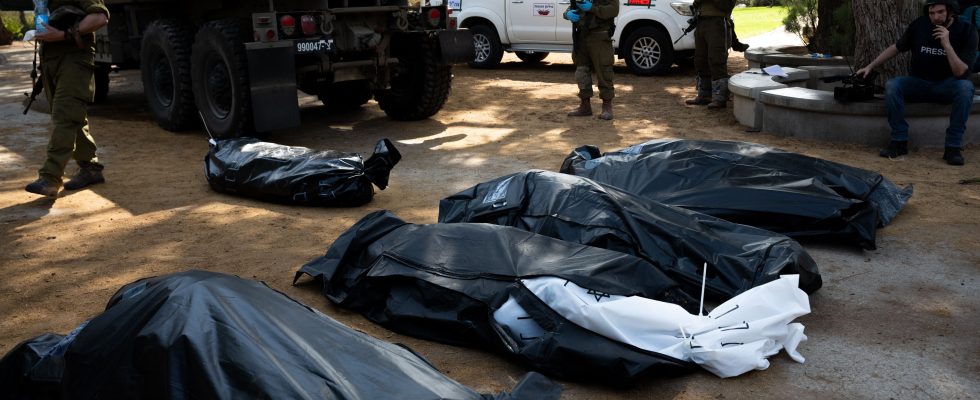“Hi Thomas. Have you heard what happened to Kibbutz Kfar Aza, which we visited last year?” Usually, our facetious colleague Felix, journalist at Spiegel, sends funny messages, either to mock the French, or to regret the pitiful performances of the German football team. But there we found ourselves commenting on a real pogrom. Do we have words for this on WhatsApp?
A paradise. This was the first photo that came to us when we entered the Kibbutz Kfar Aza, an hour’s drive from Tel Aviv. On a bright day at the end of November, we gazed at the carefully manicured lawns, cypress trees, and idyllic play areas. Above all, we enjoyed the apparent calm in this rural community of 700 people. A paradise, certainly, but resolutely atheist and progressive. Founded in 1951, Kfar Aza has always been within Israel’s borders as recognized by the United Nations. Here, no religious settlers, but socialist Jews hated by the Israeli right. The inhabitants there practiced collectivism, an equality between all that could not even be imagined by the most anti-capitalist of the current deputies of La France insoumise. No bank account, everyone being evaluated according to their work.
The abolition of private property extended to children, raised together by age group and separated from their parents, who only saw them for a few hours a day. Like all kibbutzim, Kfar Aza gave up part of this Rousseauist utopia in the 1990s, while young people left for the city not to return. In order to survive and preserve the population, housing was privatized, children joined their parents, salaries began to come from outside the kibbutz. But Kfar Aza has retained a strong sense of community, with, in the middle of the village, a canteen and large tables on which you share your meal tray.
Incendiary rockets and balloons
Then, after serving us lemonade on his terrace, our host, Chen Kotler Abrahams, revealed hell to us. A former Israeli television producer turned consultant, this dynamic fifty-year-old has brought out her small personal museum of missile and mortar remains. Two unique patrons: Hamas and Islamic Jihad. It was then that we paid more attention to the multiple loudspeakers scattered throughout the kibbutz, to the shell holes on the elementary school, to the omnipresent white air raid shelters. Located just 2 kilometers from the border with Gaza, Kfar Aza lived to the rhythm of alerts and bombings. From a very young age, children, when the sirens sounded (“red alert”), were trained to run, in just a few seconds, into a fortified area. But the most perverse thing, railed Chen Kotler Abrahams, were the incendiary balloons sent from Gaza. While a colorful balloon brings joy to all the toddlers on the planet, those in Kfar Aza were taught to flee these “gifts” from Hamas.
Chen’s parents moved here in 1973, the year of the Yom Kippur War. She left the kibbutz to do her military service and pursue a career in the media. Then she returned to raise her only son with her family. The incessant alerts, the attacks coming from the sky, the countdown in his head to take shelter, the worry of knowing where the children are have not always been his daily life. Chen spoke of the days when residents of Kfar Aza would go to Gaza’s beaches, markets or seafood restaurants on weekends. But the second Intifada, in 2000, changed everything. In 2005, Prime Minister Ariel Sharon withdrew the Israeli military from Gaza, removing all settlements there. In 2006, Hamas won the legislative elections there (the most recent) and took power. Since then, Kfar Aza has alternated between peace and war, in just a few seconds.
But all this was still nothing compared to the terror which fell on the kibbutz on Saturday October 7, around 6:30 a.m., carried by 70 Hamas terrorists. While liberating the village on the night of October 9 to 10, the Israeli soldiers discovered a mass grave. Babies, children, women had been massacred. According to a first testimony, some victims were decapitated – nuanced information from French correspondent Samuel Forey (Le Monde, Le Soir). Hamas set fire to houses to force out the residents, many of whom preferred to die in the smoke rather than be shot by the terrorists. Around a hundred people died in this carnage. “I thought of General Eisenhower after he saw the death camps in Europe,” said Major General Itai Veruv, a veteran of the region. “I had never seen anything worse. I broke down when I saw the bodies of two murdered children,” testified a young officer, Omer Barak.
The latest news is that Chen Kotler Abrahams is safe and sound. Not being in Israel at the time of the attack, she escaped to an Oradour in the Negev desert.
